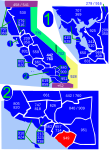Silverado High School (Mission Viejo)
AC with 0 elementsContinuation high schools in CaliforniaHigh schools in Orange County, CaliforniaMission Viejo, CaliforniaPublic high schools in California ... and 1 more
Southern California school stubs
Silverado High School is a continuation high school in Mission Viejo, California, United States. It is part of the Saddleback Valley Unified School District.
Excerpt from the Wikipedia article Silverado High School (Mission Viejo) (License: CC BY-SA 3.0, Authors).Silverado High School (Mission Viejo)
Peter A Hartman Way, Mission Viejo
Geographical coordinates (GPS) Address Nearby Places Show on map
Geographical coordinates (GPS)
| Latitude | Longitude |
|---|---|
| N 33.620474262125 ° | E -117.6831333265 ° |
Address
Silverado High School
Peter A Hartman Way 25632
92691 Mission Viejo
California, United States
Open on Google Maps









